Dubai International Airport
Dubai International Airport (IATA: DXB, ICAO: OMDB) (Arabic: مطار دبي الدولي) is the primary international airport serving Dubai, United Arab Emirates, and is the world's busiest airport by international passenger traffic.[4] It is also the fifth-busiest airport in the world by passenger traffic,[5] the sixth-busiest cargo airport in the world,[6] the busiest airport for Airbus A380 and Boeing 777 movements,[7] and the airport with the highest average number of passengers per flight.[8] In 2017, DXB handled 88 million passengers and 2.65 million tonnes of cargo and registered 409,493 aircraft movements.[9] In July 2019, Dubai International airport installed the largest solar energy system in the region's airports as part of Dubai's goal to reduce 30 percent of the city energy consumption by 2030.[10]
Dubai International Airport مطار دبي الدولي Maṭār Dubayy al-Duwalī | |||||||||||||||
|---|---|---|---|---|---|---|---|---|---|---|---|---|---|---|---|
 | |||||||||||||||
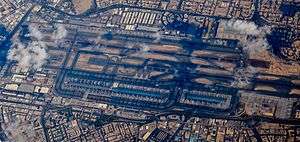 | |||||||||||||||
| Summary | |||||||||||||||
| Airport type | Public | ||||||||||||||
| Owner | Government of Dubai | ||||||||||||||
| Operator | Dubai Airports Company | ||||||||||||||
| Serves | Dubai, United Arab Emirates | ||||||||||||||
| Hub for | |||||||||||||||
| Elevation AMSL | 62 ft / 19 m | ||||||||||||||
| Coordinates | 25°15′10″N 055°21′52″E | ||||||||||||||
| Website | dubaiairports.ae | ||||||||||||||
| Map | |||||||||||||||
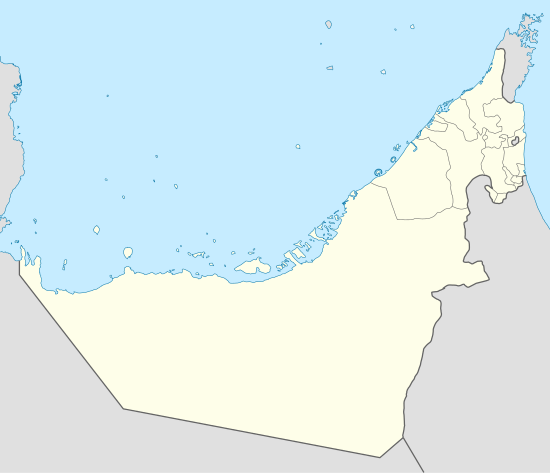 DXB/OMDB Location in the UAE 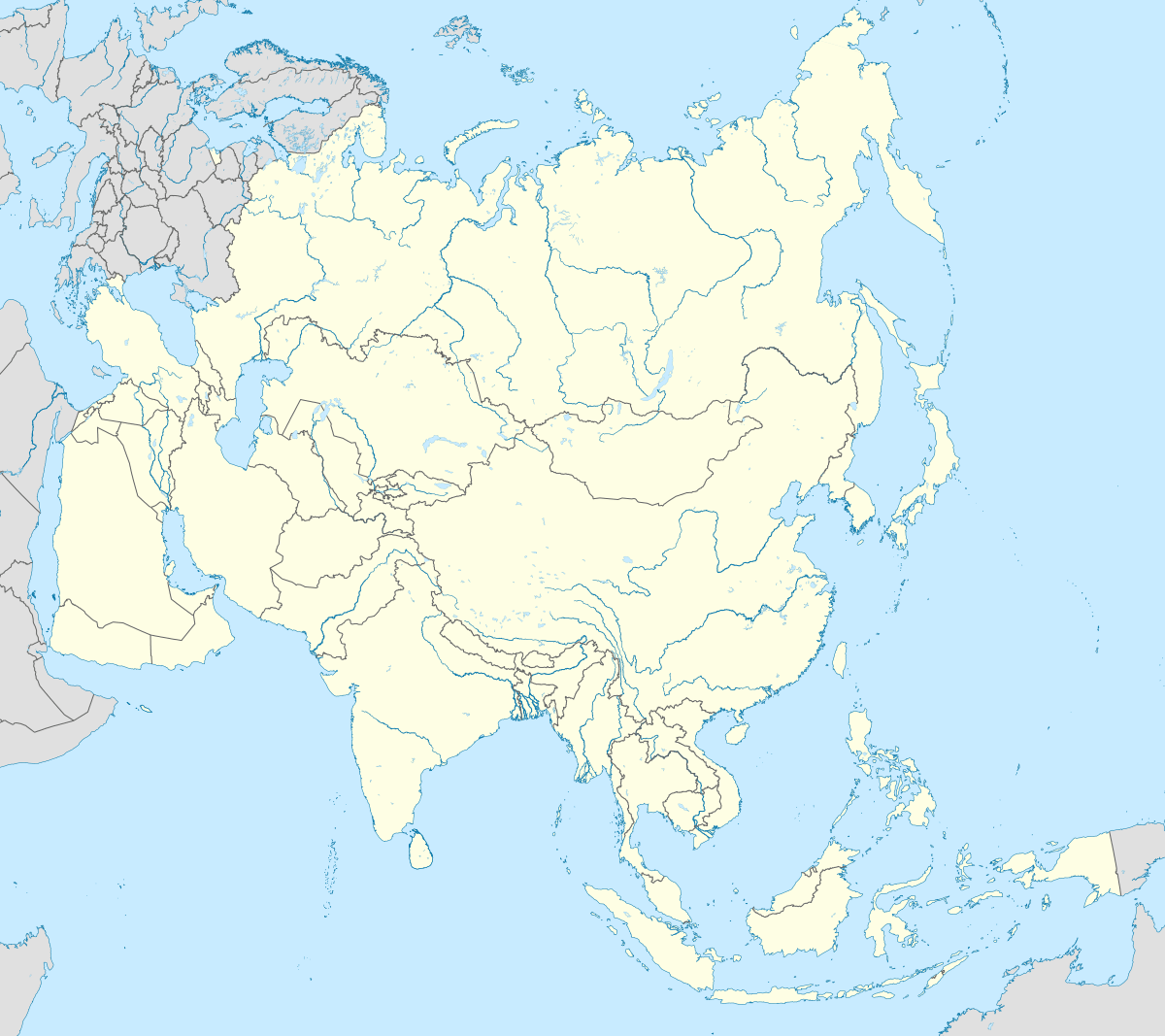 DXB/OMDB DXB/OMDB (Asia) | |||||||||||||||
| Runways | |||||||||||||||
| |||||||||||||||
| Statistics (2019) | |||||||||||||||
| |||||||||||||||
Dubai International Airport is situated in the Al Garhoud district, 2.5 nautical miles (4.6 km; 2.9 mi) east[2] of Dubai and spread over an area of 7,200 acres (2,900 ha) of land.[11] Terminal 3 is the second-largest building in the world by floor space and the largest airport terminal in the world.[12]
Emirates Airline has its hub airport in Dubai International (DXB) and has their own terminal 3 with 3 concourses that they share with flydubai. The Emirates hub is the largest airline hub in the Middle East; Emirates handles 51% of all passenger traffic and accounts for approximately 42% of all aircraft movements at the airport.[13][14] Dubai Airport is also the base for low-cost carrier flydubai which handles 13% of passenger traffic and 25% of aircraft movements at DXB.[15] The airport has a total capacity of 90 million passengers annually. As of January 2016, there are over 7,700 weekly flights operated by 140 airlines to over 270 destinations across all inhabited continents.[16] Over 63% of travelers using the airport in 2018 were connecting passengers.[17]
Dubai International is an important contributor to the Dubai economy, as it employs approximately 90,000 people, indirectly supports over 400,000 jobs and contributes over US$26.7 billion to the economy, which represents around 27 per cent of Dubai's GDP and 21% of the employment in Dubai.[18] It is predicted that by 2020, the economic contribution of Dubai's aviation sector will rise to 37.5% of the city's GDP and by 2030, the economic impact of aviation is projected to grow to $88.1 billion and support 1.95 million jobs in Dubai or 44.7% of the GDP and 35.1% of the total employment.[1][19]
History
The history of civil aviation in Dubai started in July 1937 when an air agreement was signed for a flying boat base for the aircraft of Imperial Airways with the rental of the base at about 440 rupees per month—this included the guards' wages. The Empire Flying Boats also started operating once a week flying east to Karachi and west to Southampton, England. By February 1938, there were four flying boats a week.
In the 1940s, flying from Dubai was by flying boats operated by British Overseas Airways Corporation (BOAC), operating the Horseshoe route from Southern Africa via the Persian Gulf to Sydney.[20]
Construction

Construction of the airport was ordered by the ruler of Dubai, Sheikh Rashid bin Saeed Al Maktoum, in 1959. It officially opened in 1960 with its first airfield, at which time it was able to handle aircraft the size of a Douglas DC-3 on a 1,800-metre-long (5,900 ft) runway made of compacted sand.[21] Three turning-areas, an apron and small terminal completed the airport that was constructed by Costain.[22]
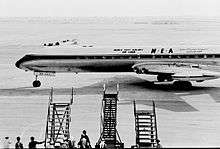
In May 1963, construction of a 9,200-foot (2,800 m) asphalt runway started. This new runway, alongside the original sand runway and taxiway opened in May 1965, together with several new extensions were added to the Terminal Building, hangars erected, Airport and Navigational aids were installed. The installation of the lighting system continued after the official opening and was completed in August of that year. During the second half of the 1960s several extensions, equipment upgrades like a VHF omnidirectional range (VOR) and an instrument landing system (ILS), as well as new buildings, were constructed. By 1969, the airport was served by 9 airlines serving some 20 destinations.[23]
The inauguration was on 15 May 1966 and was marked by the visits of the first big jets of Middle East Airlines and Kuwait Airways Comets.[24]
The advent of wide-body aircraft required further airport development in the 1970s, which had already been foreseen by the Ruler of Dubai, and plans for a new Terminal, runways, and taxiways capable of coping with international flights were drawn up. The construction of a new terminal building consisting of a three-storey building 110 m (360 ft) long and included an enclosed floor area of 13,400 m2 (144,000 sq ft). A new 28 m (92 ft) control tower was also constructed.[25]
Expansion continued in the early 1970s including ILS Category II equipment, lengthening existing runway to 12,500 ft (3,810 m), installation of a non-directional beacon (NDB), diesel generators, taxiways, etc. This work made handling the Boeing 747 and Concorde possible. Several runway and apron extensions were carried out through the decade to meet growing demand.[26]
1971 saw the new precision category 2 Approach and Runway Lighting System being commissioned. The construction of the Airport Fire Station and the installation of the generators were completed in December of that year and were fully operational in March 1972. The ruler also commissioned and inaugurated the Long-range Surveillance System on 19 June 1973.[27]
With the expansion of the Airport Fire Services, it was necessary to find more suitable accommodation, and a hangar style building was made available to them at the end of 1976. This was located midway between the runway ends to facilitate efficient operations. A new building was also constructed to house the Airport Maintenance Engineer, Electronics Engineering section, and Stores unit.
Expansion of the Airport Restaurant and Transit Lounge including the refurbishing of the upper level and the provision of a new kitchen was completed in December 1978.
The next phase of development was the second runway, which was completed three months ahead of schedule and opened in April 1984. This runway, located 360 m (1,180 ft) north of the existing runway and parallel to it and is equipped with the latest meteorological, airfield lighting and instrument landing systems to give the airport a Category II classification.
Also, several extensions and upgrades of terminal facilities and supporting systems were carried out. On 23 December 1980 the airport became an ordinary member of the Airports Council International (ACI).
During the 1980s, Dubai was a stopping point for airlines such as Air India, Cathay Pacific, Singapore Airlines, Malaysia Airlines, and others traveling between Asia and Europe that needed a refueling point in the Persian Gulf. This use was later made redundant with the availability of Russian airspace due to the breakup of the Soviet Union and the advent of longer-range aircraft introduced in the late 1980s and early 1990s such as the Airbus A340, the Boeing 747-400 and the Boeing 777 series aircraft, which had the range to fly between Europe and Southeast Asia nonstop.[28] British Airways flights from Islamabad to Manchester also stopped for short times during the 1980s.
Expansion
.jpg)
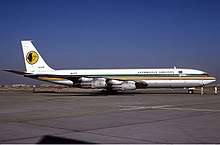
The opening of Terminal 2 in 1998 saw the first step of phase 1 of the new development master plan launched in 1997. As the second stage, Concourse 1 opened in April 2000 under the name of Sheikh Rashid Terminal. The concourse is 0.8 km (0.50 mi) in length and connects to the check-in area by a 0.3 km (0.19 mi) tunnel containing moving walkways (conveyor belt/travelators). It also contains a hotel, business center, health club, exchanges, dining and entertainment facilities, internet services, medical centre, post office and a prayer room. The next step was the reconfiguration of the runways, already part of phase 2, and aprons and taxiways were expanded and strengthened in 2003–2004. In addition, the Dubai Flower Centre opened in 2005 as part of the development. The airport saw the need for this as the city is a hub for import and export of flowers and the airport required a specialist facility since flowers need special conditions.[29][30]
Construction of Terminal 3 began in 2004 as the next stage of phase 2 of the development, with an estimated cost of around $4.55 billion. Completion was originally planned for 2006, but was delayed by two years.[31]
On 30 May 2008, a topping out ceremony was conducted. The terminal became operational on 14 October 2008, with Emirates Airline (EK2926) from Jeddah, Saudi Arabia, being the first flight to arrive at the new terminal and EK843 to Doha, Qatar being the first departing flight. The terminal increased the airport's maximum passenger capacity annually by 47 million, bringing the total annual capacity up to 75 million passengers.[32]
On 29 October 2010, the airport marked its 50th anniversary. The airport has seen over 402 million passengers at an average annual growth rate of 15.5% and handled over 3.87 million aircraft at an average annual growth rate of 12.4%.[33]
With the arrival of the Airbus A380, the airport made modifications costing $230 million. These included the building of 29 gates capable of handling the large aircraft, five of which are in Terminal 3 and two are in Terminal 1. Other important projects at the airport include the next stage of phase 2 development, which includes the construction of Concourse 3. This will be a smaller version of Concourse 2, which is connected to Terminal 3.
Also as part of the expansion, the airport is now able to handle at least 75 million (an increase of 19 million) passengers per annum with the opening of Concourse 3, which is part of Terminal 3. However, recent communications predict a further increase to 80 million passengers with additional reassessments of existing capacities. In 2009, Terminal 2 expanded its facilities to handle 5 million (an increase of 2 million) passengers annually, taking the airport's total capacity to 62 million passengers. The Department of Civil Aviation has said that Terminal 2 will be continuously upgraded and expanded to bring the total capacity of the airport from the initial 75 million passengers to 80 million passenger capacity by 2012.[34]
The Cargo Mega Terminal, which will have the capacity to handle 3 million tonnes of cargo a year, is a major development; it is going to be built in the long term. The completion of the mega terminal will be no later than 2018. Terminal 2 will be completely redeveloped to match the status of the other two terminals. With all of these projects completed by 2013, the airport expects to be able to handle at least 75–80 million passengers and over 5 million tonnes of cargo.
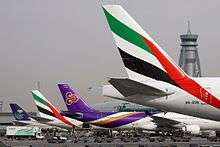
The airport's landside facilities were modified to allow the construction of two stations for the Red Line of Dubai Metro. One station was built at Terminal 1 and the other at Terminal 3. The line began service on 9 September 2009, and opened in phases over the next year.[35] The second Metro line, the Green Line, runs near the Airport Free Zone and has served the airport's north-eastern area with the Terminal 2 starting in September 2011.[36]
With phase 2 of DXB's expansion plan complete, the airport now has three terminals and three concourses, two cargo mega terminals, an airport free zone,[37] an expo center with three large exhibition halls, a major aircraft maintenance hub and a flower center to handle perishable goods.[34] A phase 3 which has been included in the master-plan involves the construction of a new Concourse 4.
The airport revealed its future plans in May 2011, which involve the construction of a new Concourse D for all airlines currently operating from concourse C. Concourse D is expected to bring the total capacity of the airport to over 90 million passengers and will open in early 2016. The plan also involves Emirates solely operating from Concourse C along with Concourse A and B.[38]
In September 2012, Dubai Airports changed the names of concourses to make it easier for passengers to navigate the airport. Concourse 1, in which over 100 international airlines operate, became Concourse C. Concourse 2 became Concourse B and Concourse 3 became Concourse A. The gates in Terminal 2 were changed and are now numbered F1 to F6. The remaining alpha-numeric sequences are being reserved for future airport facilities that are part of the Dubai Airports' $7.8 billion expansion programme, including Concourse D.[39]
| Summary of Dubai International Airport Masterplan | ||||
|---|---|---|---|---|
| Phase | Year | Description | ||
| Phase 1[40] | 1997 | Initial capacity of 11 million passengers per annum. $540 million phase 1 launched.[41] | ||
| 1998 | Terminal 2 inaugurated on 1 May 1998, to alleviate congestion from Terminal 1, with a capacity of 2.5 million passengers annually.[42] | |||
| 2000 | Sheikh Rashid Terminal (Concourse C) – reopened 15 April 2000. Capable of handling 22 million passengers per annum.[43] | |||
| Phase 2[29] | ||||
| 2002 | $4.5 bn ($545 m for the civils on T3 and concourse projects) launched. | |||
| 2003 | Taxiways were strengthened. In addition, work on other taxiways in the area was expanded in order to complete the work associated with the newly commissioned second runway.[44] | |||
| 2005 | Construction of Dubai Flower Centre completed.[45] | |||
| 2005 | US$225 million VIP Pavilion for the Dubai Royal Wing opens in July.[46] | |||
| 2008 | Capable of handling 60 million passengers per annum with the opening of Terminal 3 – Concourse B[47] | |||
| 2012 | Extensions to Terminal 2 are completed – new check-in hall, departure area, and extensions to the terminal building. | |||
| 2013 | New Concourse A constructed, enabling the airport to have a capacity of 80 million passengers.[34] | |||
| 2016 | Concourse D will be completed with a capacity of 15 million passengers. All airlines currently operating from concourse C will move to D. | |||
| General Expansion | 2004–2008 | Includes construction of Emirates Flight Catering Centre, Emirates Engineering Facility. | ||
| 2006 | Opening of Emirates Engineering Facility – largest aircraft hangars in the world.[48] | |||
| 2007 | Opening of Emirates Flight Catering Centre, capable of producing 115,000 meals per day.[49] | |||
| 2008 | New Executive Flights Centre facility launched.[50] | |||
| 2014 | Runway refurbishment and upgrades after an 80-day project which ran from 1 May to 20 July 2014. During this period, DXB operated with one single runway. New LED lighting replaced the old tungsten runway lights and new taxiways were constructed enabling an increase in runway capacity.[51] | |||
| 2015 | Terminal 2 capacity increased to 10 million after expansion completed.[52] | |||
Dubai's government announced the construction of a new airport in Jebel Ali, named Dubai World Central – Al Maktoum International Airport. It is expected to be the second-largest airport in the world by physical size, though not by passenger metrics. It opened 27 June 2010;[53] however, construction is not expected to finish until 2027. The airport is expected to be able to accommodate up to 160 million passengers.[54][55][56] There has been an official plan to build the Dubai Metro Purple Line to connect Al Maktoum International Airport to Dubai International Airport; construction was set to begin in 2012. The proposed 52 km (32 mi) Purple Line will link Dubai International Airport and Al Maktoum International Airport.[57]
Concourse D opened on 24 February 2016 for all international airlines and moved out of the Terminal 1. Emirates now operates from Concourse A, Terminal 3 and Terminal 1.
| Airlines | 1990 | 1994 | 1998 | 2002 | 2006 | 2010 | 2014 |
|---|---|---|---|---|---|---|---|
| Passenger movements | 4.347 million | 6.299 million | 9.732 million | 15.973 million | 28.788 million | 47.181 million | 70.476 million |
| Airfreight movements (tonnes) | 144,282 | 243,092 | 431,777 | 764,193 | 1.410 million | 2.19 million | 2.37 million |
| City links | 36 | 54 | 110 | 170 | 195 | 210 | 240 |
| Weekly scheduled flights | N/A | N/A | 2,350 | 2,850 | 4,550 | 6,100 | 7,500 |
| Airlines | N/A | N/A | 80 | 102 | 113 | 135 | 140 |
On 20 December 2018 the airport celebrated its one billion passenger.[60]
In February 2019, Emirates signed a deal with Airbus for 40 A330-900s and 30 A350-900s, while reducing its A380 order;[61] 14 A380s remained to be delivered, after which Airbus will cease production of the A380.[62]
Air traffic
Main airlines based at DXB
_-_Raihan_Bakhsh.jpg)
- Emirates Airline is the largest airline operating at the airport, with an all-wide-body fleet of over 200 Airbus and Boeing aircraft based at Dubai, providing scheduled services to the Middle East, Africa, Asia, Europe, North America, South America, Australia and New Zealand. It operates out of Terminal 3, Concourses A, B and C.[63]
- Emirates SkyCargo, a subsidiary of Emirates, operates scheduled all-cargo services between Dubai and the rest of the world.[64]
- Flydubai, a low-cost airline planning to operate over 100 aircraft on scheduled passenger services to and from Dubai, to the Middle East, Africa, Europe and South Asia. It operates from Terminal 2[65] and, since December 2018, also from Terminal 3 for selected destinations.[66][67]
Recreational flying to Dubai is catered for by the Dubai Aviation Club, which undertakes flying training for private pilots and provides facilities for private owners.[68]
The Government of Dubai provides short and long range search and rescue services, police support, medical evacuation and general purpose flights for the airport and all VIP flights to the airport.[69]
Statistics
| Operations and statistics | |||
|---|---|---|---|
| Passenger movements | |||
| 2003 | 18,062,344 | 2010 | 47,180,628 |
| 2004 | 21,711,883 | 2011 | 50,977,960 |
| 2005 | 23,607,507 | 2012 | 57,684,550 |
| 2006 | 28,788,726 | 2013 | 66,431,533 |
| 2007 | 34,340,000 | 2014 | 70,475,636 |
| 2008 | 37,441,440 | 2015 | 78,014,841 |
| 2009 | 40,901,752 | 2016 | 83,654,250 |
| 2017 | 88,242,099 | ||
| 2019 | 86,396,757 | ||
| Airfreight movements in tonnes | |||
| 2003 | 928,758 | 2010 | 2,270,498 |
| 2004 | 1,111,647 | 2011 | 2,199,750 |
| 2005 | 1,333,014 | 2012 | 2,279,624 |
| 2006 | 1,410,963 | 2013 | 2,435,567 |
| 2007 | 1,668,505 | 2014 | 2,367,574 |
| 2008 | 1,824,991 | 2015 | 2,506,092 |
| 2009 | 1,927,520 | 2016 | 2,592,454 |
| Aircraft movements | |||
| 2003 | 148,334 | 2010 | 292,662 |
| 2004 | 168,511 | 2011 | 326,317 |
| 2005 | 195,820 | 2012 | 344,245 |
| 2006 | 217,165 | 2013 | 369,953 |
| 2007 | 260,530 | 2014 | 357,339 |
| 2008 | N/A | 2015 | 406,625 |
| 2009 | N/A | 2016 | 418,220 |
| Capacity | |||
| Passenger (current) | 83,000,000 | ||
| (ultimate) | 90,000,000 | ||
| Cargo (current) | 2.5m tonnes | ||
| Cargo (ultimate) | 2.5m tonnes | ||
| Apron (current) | 173 | ||
| Number of destinations | |||
| (air) | 240 | ||
| Number of airlines | |||
| International | 140+ | ||
Infrastructure
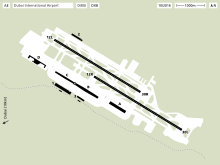
| Infrastructure[70][71] | ||
|---|---|---|
| Taxiways | ||
| Length | 25,300 m (83,000 ft) | |
| Width | 30 m (98 ft) | |
| Passenger terminal buildings | ||
| Total | ||
| Floor area | 1,972,474 m2 (21,231,530 sq ft) | |
| Handling capacity | 93 million passengers[72] | |
| Parking bays | 73 (aerobridge) 100 (remote) | |
| Terminal One + (Concourse C)[73] | ||
| Opened | 1 April 2000 (operational) | |
| Floor area | 246,474 m2 (2,653,020 sq ft) | |
| Handling capacity | 22 million passengers | |
| Parking bays | 69 Aircraft Stands (32 stands shared between T1, T2, and T3) | |
| Concourse D[74] | ||
| Opened | 2016 | |
| Floor area | 150,000 m2 (1,600,000 sq ft) | |
| Handling capacity | 18 million | |
| Parking bays | 19 aircraft stands | |
| Terminal Two[75] | ||
| Opened | 1 May 1998 (operational) | |
| Floor area | 13,000 m2 (140,000 sq ft) | |
| Handling capacity | 10 million passengers | |
| Parking bays | 37 aircraft stands (2 stands shared with T1) | |
| Terminal Three + (Concourse A and B)[76] | ||
| Opened | 14 October 2008 (operational) | |
| Floor area | 1,713,000 m2 (18,440,000 sq ft): Terminal 3 (515,000 m2) + Concourse A (528,000 m2) + Concourse B (670,000 m2) | |
| Handling capacity | 43 million passengers: Concourse A (19 million) + Concourse B (24 million) | |
| Parking bays | 99 aircraft stands (30 shared between T1, T2 and T3) | |
| VIP Pavilion | ||
| Opened | January 2005 (operational) | |
| Floor area | N/A | |
| Handling capacity | N/A | |
| Parking bays | N/A | |
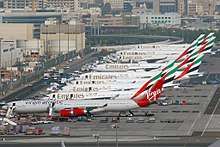
Dubai International Airport was conceptualized to function as Dubai's primary airport and the region's busiest for the foreseeable future without the need for relocation or the building of another airport when passenger figures increased. The area was chosen near to Dubai, to attract passengers from the city of Dubai, rather than travel to the busier Sharjah International Airport. The planned location originally was Jebel Ali.[77]
The original master plan for the existing airport initially involved a dual-terminal and one runway configuration over two phases with provisions for another two passenger terminals in the near future. Phase 1 included the construction for the first passenger terminal, the first runway, 70 aircraft parking bays, support facilities and structures, including large maintenance hangar, the first fire station, workshops, and administrative offices, an airfreight complex, two cargo agents' buildings, in-flight catering kitchens and an 87 m (285 ft) control tower. Construction for the second phase would commence immediately after the completion of Phase 1 and include the second runway, 50 new aircraft parking bays in addition to the existing 70 bays, a second fire station and a third cargo agent building.[78]
The third phase included the construction of a new terminal (now the parts of Terminal 1's main building and Concourse C) and an additional 60 parking bays, as well as a new aircraft maintenance facility. Then, in the early 2000s (decade) a new master plan was introduced which began the development of the current concourses and terminal infrastructure.[79]
Paul Griffiths (Dubai Airports' CEO) in his interview to Vision magazine, cited plans to build infrastructure to support the expansion of Emirates and budget airline flydubai, and ascend the ranks of global aviation hubs.[80]
Control tower
The 87-metre-tall (285 ft) airport traffic control tower (ATCT) was constructed as part of phase two of the then-development plan.[81]
Terminals
Dubai International Airport has three terminals. Terminal 1 has one concourse (concourse D), Terminal 2 is set apart from the other two main buildings and Terminal 3 is divided into Concourse A, B, and C. The cargo terminal is capable of handling 3 million tonnes of cargo annually and a general aviation terminal (GAT) is close by.[29]
_AN1459470.jpg)
_AN1204297.jpg)
Passenger terminals
Dubai Airport has three passenger terminals. Terminals 1 and 3 are directly connected with a common transit area, with airside passengers being able to move freely between the terminals without going through immigration, while Terminal 2 is on the opposite side of the airport. For transiting passengers, a shuttle service runs between the terminals, with a journey time of around 20 minutes from Terminal 2 to Terminal 1 and 30 minutes to Terminal 3. Passengers in Terminal 3 who need to transfer between concourse A and the rest of the Terminal have to travel via an automated people mover. Also after early 2016 when the construction of Concourse D was done, there is now an automated people mover between concourse D and Terminal 1.[82]
Situated beside Terminal 2 is the Executive Flights Terminal, which has its own check-in facilities for premium passengers and where transportation to aircraft in any of the other terminals is by personal buggy.
The three passenger terminals have a total handling capacity of around 80 million passengers a year.
Terminals 1 and 3 cater to international passengers, whilst Terminal 2 is for budget passengers and passengers flying to the subcontinent and Persian Gulf region; Terminals 1 and 3 handle 85% of the passenger traffic and the Executive Flights terminal is for the higher-end travelers and important guests.
Terminal 1
Terminal 1 has a capacity of 15 million passengers. It is used by over 100 airlines and is connected to Concourse D by an automated people mover. It is spread over an area of 520,000 m2 (5,600,000 sq ft) and offers 221 check-in counters.
The Terminal was originally built to handle 18 million passengers; however, with extreme congestion at the terminal, the airport was forced to expand the terminal to accommodate the opening of 28 remote gates. Over the years, more mobile gates were added to the airport bringing the total as of 2010 to 28.
In 2013, Dubai Airports announced a major renovation for Terminal 1 and Concourse C. The renovations include upgraded baggage systems, replacement of check-in desks and a more spacious departure hall. Arrivals will also see improvements to help reduce waiting times. The renovation was completed by the middle of 2015.[83]
- Concourse D
Planning begun for further expansion of Dubai Airport, with the construction of Terminal 4, it was revealed on the day Emirates completed its phased operations at the new Terminal 3, on 14 November 2008.[84] According to Dubai Airport officials, plans for Terminal 4 had begun and extensions would be made to Terminal 3. These are required to bring the capacity of the airport to 80–90 million passengers a year by 2015.[85]
In May 2011, Paul Griffiths, chief executive of Dubai Airports revealed the Dubai Airport masterplan. It involves the construction of Concourse D (previously Terminal 4). With a capacity of 15 million, it would bring the total capacity of the airport to 90 million passengers by 2018—an increase of 15 million. It also will see Emirates take over the operation at Concourse C, along with concourse A and B which it will already be operating. All remaining airlines will shift to Concourse D, or move to Al Maktoum International Airport. The airport projects that international passenger and cargo traffic will increase at an average annual growth rate of 7.2% and 6.7%, respectively, and that by 2020 passenger numbers at Dubai International Airport will reach 98.5 million and cargo volumes will top 4.1 million tonnes.[86]
Concourse D will have a capacity of 15 million passengers, include 17 gates and will be connected to Terminal 1 via an automated people mover.[87] On 6 February 2016, members of the public were invited to trial the concourse in preparation for its opening. On Wednesday, 24 February 2016, Concourse D officially opened with the first British Airways flight arriving at gate D8.[88]
Terminal 2
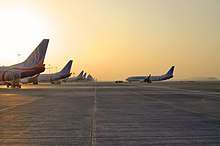
[89] Terminal 2 built in 1998 has an area of 47,000 m2 (510,000 sq ft) and has a capacity of 10 million as of 2013, after several, decent reconstructions and a major expansion in 2012 which saw capacity double. It is used by over 50 airlines, mainly operating in the Persian Gulf region. Most flights operate to India, Saudi Arabia, Iran, Afghanistan and Pakistan.
In June 2009, Terminal 2 became the hub of Air India Express and flydubai,[90] and the terminal houses the airline's corporate head office.[91]
Terminal 2 has undergone a major refurbishment recently, extending check-in and boarding facilities, changing the interior and exterior décor, and offering more dining choices to passengers. Capacity was increased to allow for 10 million passengers, an increase of 5 million.[92]
The terminal has now increased the number of facilities available to passengers. Check-in counters have increased to 37. The boarding area is more spacious, with more natural light. Also the new open boarding gates allow several flights to board simultaneously, improving passenger and aircraft movements. There are a total of 43 remote stands at the terminal. However, passengers cannot move between Terminal 2 to 1 or from 2 to 3 and vice versa inside the airport. They have to make use of Taxi service or public transport available outside.
The Dubai duty-free shopping area covers 2,400 m2 (26,000 sq ft) in departures and 540 m2 (5,800 sq ft) in arrivals.[89] The 3,600-square-metre (39,000 sq ft) extension included a larger arrivals hall as well.
Terminal 3
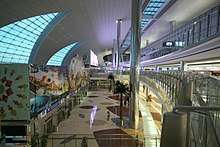
The partly underground Terminal 3 was built at a cost of US$4.5 billion, exclusively for Emirates and has a capacity of 65 million passengers. The terminal has 20 Airbus A380 gates at Concourse A and 5 at Concourse B and 2 at Concourse C.[93] It was announced on 6 September 2012 that Terminal 3 would no longer be Emirates-exclusive, as Emirates and Qantas had set up an extensive code sharing agreement. Qantas would be the second and only one of two airlines to fly in and out of Terminal 3. This deal also allows Qantas to use the A380 dedicated concourse.[94]
Upon completion, Terminal 3 was the largest building in the world by floor space, with over 1,713,000 m2 (18,440,000 sq ft) of space, capable of handling 60 million passengers in a year. A large part is located under the taxiway area and is directly connected to Concourse B: the departure and arrival halls in the new structure are 10 m (33 ft) beneath the airport's apron. Concourse A is connected to the terminal via a Terminal 3 APM.[95][96] It has been operational since 14 October 2008, and opened in four phases to avoid collapse of baggage handling and other IT systems.
The building includes a multi level underground structure, first and business class lounges, restaurants, 180 check-in counters and 2,600 car-parking spaces. The terminal offers more than double the previous retail area of concourse C, by adding about 4,800 m2 (52,000 sq ft) and Concourse B's 10,700 m2 (115,000 sq ft) of shopping facilities.[97]
In arrivals, the terminal contains 72 immigration counters and 14 baggage carousels.[98][99] The baggage handling system—the largest system and also the deepest in the world—has a capacity to handle 8,000 bags per hour. The system includes 21 screening injection points, 49 make-up carousels, 90 km (56 mi) of conveyor belts capable of handling 15,000 items per hour at a speed of 27 km/h (17 mph) and 4,500 early baggage storage positions.[100]
- Concourse A
Concourse A, part of Terminal 3, opened 2 January 2013,[101] has a capacity of 19 million passengers and is connected to the two major public levels of Terminal 3 via Terminal 3 APM in addition to the vehicular and baggage handling system utility tunnels for further transfer. The concourse opened on 2 January 2013 and was built at a cost of US$3.3 billion.[102] The building, which follows the characteristic shape of Concourse B, 924 m (3,031 ft) long, 91 m (299 ft) wide and 40 m (130 ft) high in the centre from the apron level and accommodates 20 air bridge gates, of which all are capable of handling the Airbus A380-800.[103][104] There are also 6 remote lounges for passengers departing on flights parked at 13 remote stands. The gates in concourse A are labelled A1–A24.[39][105]
The concourse includes one 4-star hotel and one 5-star hotel, first- and business-class lounges, and duty-free areas. The total built-up area is 540,000 m2 (5,800,000 sq ft).[106] The concourse allows for multi-level boarding and boasts the largest first and business class lounges in the world. Each lounge has its own dedicated floor offering direct aircraft access from the lounges. The total amount of retail space at the concourse is 11,000 m2 (120,000 sq ft), and there is also a total of 14 cafes and restaurants.
The total retail area in the concourse is approximately 11,000 m2 (120,000 sq ft).[107]
- Concourse B
_AN1885939.jpg)
Concourse B is directly connected to terminal 3 and is dedicated exclusively to Emirates. The total built up area of the concourse itself is 675,000 m2 (7,270,000 sq ft). The concourse is 945 m (3,100 ft) long, 90.8 m (298 ft) wide (at midpoint) and 49.5 m (162 ft) high. The terminal has 10 floors (4 basements, a ground floor and 5 above floors). The building currently includes a multi-level structure for departures and arrivals and includes 32 gates, labelled B1–B32.[39] The concourse has 26 air bridge gates and 5 boarding lounges for 14 remote stands that are for Airbus A340 and Boeing 777 aircraft only. For transit passengers the concourse has 3 transfer areas and 62 transfer desks.[108]
The concourse also includes the Emirates first and Business class lounges, and the Marhaba lounge. The First class lounge has a capacity of 1,800 passengers and a total area of 12,600 m2 (136,000 sq ft). The Business class lounge has a capacity of 3,000 passengers and a total area of 13,500 m2 (145,000 sq ft). The Marhaba lounge, the smallest lounge at the concourse has a capacity of 300 passengers at a time.[109]
The total retail area at the concourse is 120,000 m2 (1,300,000 sq ft), which also includes 18 restaurants within the food court. There are also three hotels in the concourse; a 5-star hotel and a 4-star hotel.[110]
There is a direct connection to Sheikh Rashid Terminal (Concourse C) located at the control tower structure through passenger walkways. There is also a 300-room hotel and health club including both five and four star rooms. Concourse B includes five aerobridges that are capable of handling the new Airbus A380.[111] Emirates Airline continues to maintain a presence in Concourse C, operating 12 gates at the concourse as well as the Emirates First Class and Business Class Lounges.[112]
- Concourse C
Concourse C, is a part of Terminal 3, was opened in 2000 and used to be the largest concourse at Dubai International Airport before Concourse B in Terminal 3 opened. It incorporates 50 gates, including 28 air bridges and 22 remote gates located at a lower level of the terminal. The gates are labelled C1–C50.[39]
The concourse includes over 17 food and beverage cafes and restaurants, with the food court being located on the Departures Level. Also located in the concourse is a 5-star hotel and a 5,400 m2 (58,000 sq ft) duty-free shopping facility. Other facilities include prayer rooms and a medical centre. Concourse C became part of Terminal 3 in 2016 after concourse D opened.
Al Majlis VIP Pavilion and Dubai Executive Flight Terminal
_AN1620809.jpg)
The Al Majlis VIP pavilion was exclusively built for the Dubai Royal Air Wing and opened on 1 July 2008. The entire facility is a 3,400-square-metre (37,000 sq ft) terminal, and includes a Royal Majlis and an antenna farm. It also includes eight aircraft hangars with a total built up area of 69,598 m2 (749,150 sq ft) and maintenance hangars for Boeing 747s and Airbus A380s, and a 1,200-square-metre (13,000 sq ft) gatehouse for VIP service.[46] In 2010 there were 47,213 customers, 13,162 movements and in 2009, there were a total of 43,968 customers and 14,896 movements.[113]
Executive Flight Services (EFS) caters to those passengers of high class or special importance that travel through Dubai International Airports. It is the largest dedicated business aviation terminal of its kind in the Middle East. It is located at the Dubai Airport Free Zone close to Dubai International's Terminal 2. It only caters to private flights exclusive to the terminal. Airlines operating from the terminal are expected to maintain a lounge. In 2010, EFS handled 7,889 aircraft movements and 25,177 passengers.[114]
The centre itself is located close to Terminal 2, and includes a 5,500 m2 (59,000 sq ft) two-storey main building, a 3,700 m2 (40,000 sq ft) hangar, a 3,700 m2 (40,000 sq ft) ramp area for aircraft parking and a special VIP car park for long term parking. The centre also has its own immigration and customs sections, its own Dubai Duty Free outlet, a fully equipped business and conference centre, eight luxury private lounges and a limousine service between aircraft and the terminal. The ramp area of the terminal can accommodate up to 22 small-sized private jets, between 8 and 12 medium-sized jets or up to four large-sized jets such as a Boeing Business Jet (BBJ), the Boeing 727 or the Airbus A319. The facility makes EFC the largest dedicated business aviation terminal in the Middle East.
Cargo Mega Terminal
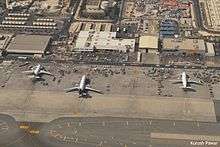
The cargo village at Dubai International Airport is one of the world's largest and most central cargo hubs, with most of the cargo for Asia and Africa coming through the facility. Forecasts in 2004 for cargo growth predicted that additional major cargo handling facilities were needed to satisfy demands. Plans were put in place to construct the first stage of the cargo mega terminal, which by 2018 will have the ability to handle three million tons of freight.[115] Phase 1 of the cargo mega terminal was completed by 2004 and the next phase of expansion was scheduled for completion in late 2007. Presently the airport has a cargo capacity of 2.5 million tonnes, and will be expanded to handle 3 million.[116]
Flower centre
Dubai Airport has constructed a flower centre to handle flower imports and exports, as Dubai is a major hub for the import and export of flowers, and the airport required a specialist facility since these products need special conditions.[117] The flower centre's first phase was completed in 2004 at a cost of $50 million.[118]
The centre when completed and functioning will have a floor area of approximately 100,000 m2 (1,100,000 sq ft) including different export chambers and offices. The handling capacity of the centre is expected to be more than 300,000 tonnes of product throughput per annum. The entire facility (with the exception of the offices) will be maintained at an ambient temperature of just 2 to 4 °C (36 to 39 °F).[119]
Runways
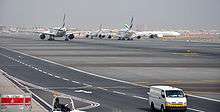
Dubai Airport has two closely spaced parallel runways, 12R/30L is 4,000 m × 60 m (13,120 ft × 200 ft), 12L/30R is 4,000 m × 60 m (13,120 ft × 200 ft). The gap between the centrelines of the two runways is 385 m (1,263 ft). The runways are equipped with four sets of ILS to guide landing aircraft safely under very poor weather conditions. The runways were expanded to accommodate the Airbus A380 which came into service in 2007.[29] In 2009, it was announced that the airport installed a Category III landing system, allowing planes to land in low-visibility conditions, such as fog. This system will be the first of its kind in the United Arab Emirates.
In 2013 Dubai Airports announced an 80-day runway refurbishment program which started on 1 May 2014 and was completed on 21 July 2014. The northern runway was resurfaced while lighting upgrades and additional taxiways were built on the southern runway to help boost its capacity. The southern runway was closed from 1 to 31 May 2014, while the northern runway was closed from 31 May to 20 July 2014. Due to extra congestion on one runway, all freighter, charter and general aviation flights were diverted to Al Maktoum International Airport.[120][121] Flights at DXB were reduced by 26% and 14 airlines moved to Al Maktoum International Airport whilst the runways works were being done. Emirates cut 5,000 flights and grounded over 20 aircraft during the period.[122]
Dubai Airports plans to close the southern runway (12R/30L) for complete resurfacing and replacement of the airfield lighting and supporting infrastructure. This will be done during a 45-day period from 16 April 2019 to 30 May 2019. This upgrade will boost safety, service and capacity levels at DXB.[123] Airlines will be required to reduce flight operations at DXB due to single runway operations.[124]
Accommodating the Airbus A380
With Dubai-based Emirates being one of the launch customers for the Airbus A380 and also the largest customer, Dubai Airport needed to expand its existing facilities to accommodate the very large aircraft. The Department of Civil Aviation spent $120 million in upgrading both of its terminals and airport infrastructure, including enlarged gate holdrooms, new finger piers, an enlarged runway, new airbridges and extended baggage belt carousels from the normal 70 to 90 m (230 to 300 ft). Dubai Airport also invested $3.5 billion into a new Concourse A, exclusively for handling Emirates A380s. With the changes made, the airport does not expect embarking and disembarking passengers and baggage from the A380 to take longer than it does for Boeing 747-400s, which carry fewer passengers. On 16 July 2008, Dubai Airport unveiled the first of two specially-built gates capable of handling the aircraft. Costing $10 million, the gates will enable passengers to get on the upper cabin of the new 555-seater aircraft directly from the gate hold rooms. The hold rooms themselves have been enlarged to cater for the larger number of passengers flying the A380s. In addition to the two gates at Terminal 1, five more A380-capable gates were opened at concourse B on 14 October 2008. Concourse A opened on 2 January 2013.[125]
Labor controversy
Most of the staff employed at construction sites across the country are foreign short-term workers from neighboring Arab states and Southeast Asia. This is because generally many UAE locals prefer to work in government companies, instead of private firms or blue collar jobs[126]. Workers building a new terminal at Dubai International Airport went on a sympathy strike in March 2006.[127][128] Another strike took place in October 2007. Four thousand strikers were arrested. Most of them were released some days later and those who were not local were then deported from Dubai.
Airlines and destinations
Passenger
- Notes
- ^1 Biman Bangladesh Airlines' flight from Dubai to Dhaka makes a stop at Sylhet. However, the flight from Dhaka to Dubai is non-stop.
Cargo
| Airlines | Destinations |
|---|---|
| ASL Airlines Belgium | Delhi, Liege |
| Cargolux | Hong Kong, Komatsu, Luxembourg |
| Coyne Airways | Baghdad, Balad, Djibouti, Erbil, Kabul, Kandahar, Sana'a |
| Emirates SkyCargo | Adelaide, Leipzig/Halle |
| Ethiopian Airlines | Addis Ababa |
| FedEx Express | Athens, Bangalore, Chengdu, Delhi, Goa, Hong Kong, Milan–Malpensa, Mumbai, Paris–Charles de Gaulle |
| FitsAir | Abu Dhabi, Baghdad, Balad, Colombo–Bandaranaike, Erbil, Herat, Jalalabad, Kabul, Kandahar, Lashkar Gah, Sharana, Sulaymaniyah, Tarin Kowt, Thumrait |
| Iran Air Cargo | Tehran–Imam Khomeini |
| Royal Airlines | Karachi |
| Royal Jordanian Cargo | Amman–Queen Alia |
| Silk Way Airlines | Baku |
| Spice Xpress | Nashik |
| TCS Couriers | Lahore, Karachi, Islamabad |
| UPS Airlines | Bangkok–Suvarnabhumi, Clark, Cologne/Bonn, Guangzhou, Hong Kong, Louisville, Delhi, Singapore, Sydney |
Services
Aviation services
.jpg)
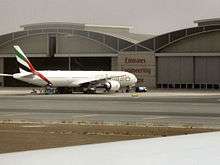
Ground handling
Ground handling services at Dubai International Airport has been provided by Dnata Ground Handling Services.
Emirates Airlines has over 2000 Airport Services employees current serving the airport.[170]
Services include cargo ramp and technical support services to airlines at Dubai Airport.[171]
Aircraft maintenance
Emirates Engineering, based in Dubai, operates the aircraft maintenance and engine test cell technical facilities at the airport. Emirates Engineering currently provides full support for the Emirates Airline fleet and all the other international operations at the airport.[172]
Current facilities include:[173][174]
- Seven aircraft hangars all capable of handling the A380 (currently the largest aircraft hangar in the world)[175]
- Aircraft painting hangar
- Aircraft processing plant
- Aircraft engine run-up facility enclosure
- Engineering Line Maintenance facility
- Engine Test Cell
- Aircraft spare parts stores
Passenger services
The airport has over 26,000 m2 (280,000 sq ft) of retail space spread between its three main terminals and includes many shopping and eating outlets.[176] The Dubai duty-free shopping area in Terminal 2 covers 1,400 m2 (15,000 sq ft) in departures and 50 m2 (540 sq ft) in arrivals. The 3,437-square-metre (37,000 sq ft) extension included a larger arrivals hall as well.
Extensive upgrading work on existing retail areas since 2004 in Terminals 1 and 2 has increased sales. Dubai Duty Free Company announced annual sales of Dhs5.9 billion (US$1.6 billion) in 2012, representing a 10 per cent increase on the previous year. In 2008, Dubai Duty Free doubled its retail space from 7,000 to 15,000 m2 (75,000 to 161,000 sq ft) with the inauguration of the new Emirates Terminal 3 in October 2008. Dubai Duty Free recorded more than 23.5 million transactions in 2012.[176] As of August 2009, Dubai Duty Free was the biggest single airport retail operation in the world ahead of London's Heathrow and Seoul's Incheon airports.
In addition to a wide array of duty-free shops and eating outlets, Dubai Airport has two open-air garden areas. Dubai Airport has numerous business centres located around the airport. Within the international transit area of the interconnected Terminals 1 and 2, internet and games facilities, prayer rooms, showers, spas, gym, swimming pool and three hotels are provided. Various lounge areas are provided, some including children's play areas or televisions showing news, movies and sports channels.[177] Terminal 3 has a left luggage facility operated by Emirates in the Arrivals area where layover passengers can leave their luggage for a fee while they go sightseeing.
Safety and security
.jpg)
The Civil Aviation Authority of Dubai manages the overall safety and security of the airport. Pre-screening takes place in all terminals at the entrance of the airport. Iris scanning has been implemented in all UAE airports. This type of scanning prevents those deported from the UAE for serious criminal charges from returning again using fraudulent documents (UAE nationals are exempt from iris scans).
In early 2007, Dubai Airport introduced a new type of airport screening device which not only detected weapons, but also could screen the passenger for drugs in the blood. With the new system in place, travellers entering Dubai can be jailed for four years or more if found in possession of illegal drugs (even in quantities as small as 0.001 grams (3.5×10−5 ounces)), including poppy seeds from bagels and prescription and over-the-counter medicines such as codeine.[178] A senior Dubai judge was quoted on 11 February 2008, by Seven Days saying, "These laws help discourage anyone from carrying or using drugs. Even if the amount of illegal drugs found on someone is 0.05 grams, they will be found guilty. The penalty is a minimum four years if it is for personal use. The message is clear—drugs will not be tolerated".[178] A number of travellers have been held pending charge while Dubai authorities test their possessions, blood and urine for any trace of contraband.[179]
In 2018, there were some reports from many media companies stating that Dubai airport had been attacked by drones launched by Houthi rebels from Yemen.[180]
Operations
Since there are international flights operating out from the airport, the terminals are equipped with immigration processing facilities and security scanning for all passengers including domestic, and regional passengers. Terminals 1 and 3 handle 95% of the international flights, whilst Terminal 2 mainly caters to regional flights and international flights routed to other airports in Middle East. Emirates Airline operates from only Terminal 3. Conversely, low-cost carriers such as flydubai operate flights out of Terminal 2.[181]
Passenger growth at the airport has been growing at an average rate of 18%. The airport reached its capacity of 33 million passengers per annum by 2007; however, this was still not enough to handle the growing over congestion at the airport. In 2013, the airport's capacity reached 75 million with the opening of concourse A and expansion of Terminal 2.
Passenger traffic for 2014 grew by 7.5% as 70.48 million passengers passed through Dubai International, compared to 66.43 million during the corresponding period in 2013.[182] Growth slowed down in 2014 due to the 80-day runway resurfacing project, which saw DXB operate with only one runway between May and July.
In 2014, India was DXB's biggest destination with 8.91 million passengers. The UK, Saudi Arabia and Pakistan followed with 5.38 million, 4.88 million and 3.13 million, respectively. London's Heathrow became the top city destination, recording 2,626,357 passengers. Doha followed it with 2,355,959.[183]
Cargo
The airport handled 2.37 million tonnes of air cargo in 2014, a decrease of 3.1 per cent over 2013, making it the sixth-busiest airfreight hub in the world and the busiest in the Middle East.[3] The decline was due to the runway closure, and the shifting of many cargo flights from DXB to Al Maktoum International Airport.
Ground transportation
Road
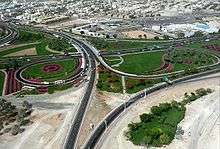
The airport is connected by the road D 89. One of the longest intra-city roads, D 89 begins at the Deira Corniche and runs perpendicular to D 85 (Baniyas Road). From Deira, the road progresses south-eastward towards Dubai International Airport, intersecting with E 311 (Emirates Road) past the airport.[184] A road tunnel underneath one of the runways was built in 2003.[185]
Metro
The airport is served by Dubai Metro, which operates two lines through or near the airport. The Red Line has a station at each of Terminal 3 and Terminal 1. Services run between 6 am and 11 pm every day except Friday, when they run between 1 pm and midnight. These timings differ during the Islamic holy month of Ramadan. The stations are located in front of both terminals and can be accessed directly from the arrivals areas.
The Green Line has at a station near the Airport Free Zone, from which passengers can connect to Terminal 2.[186]
The Purple and Blue Lines are under construction and these two lines will also have a station.[187]
Bus
Dubai Buses operated by RTA run a number of routes to the city, but mainly Deira, and are available at the Airport Ground Transportation centre and the Arrivals at every terminal.
Passengers who need to transfer between Terminals 1 and 3, and Terminal 2 can use the inter-terminal shuttle bus service which operates frequently.
Bus stations are situated opposite both Terminal 1, 2 and 3. Local buses 4, 11, 15, 33 and 44 can be used to connect with Terminal 1 and 3, while bus 2 connects with Terminal 2. Dubai International Airport Buses provide air-conditioned transport into the city centre and over 80 hotels in the city.
Emirates offers a complimentary coach service, which operates three daily services to and from Al Ain, and four daily, to and from Abu Dhabi.[188] So does Eithad.
Taxi
The airport is served by the Government owned Dubai Taxi Agency, which provides 24-hour service at the arrivals in every terminal.
Accidents and incidents
- On 14 March 1972, Sterling Airways Flight 296 crashed on approach to Dubai, killing 112.
- On July 20, 1973, Japan Air Lines Flight 404 was a passenger flight which was hijacked by Palestinian and Japanese terrorists.
- On 22 November 1974, British Airways Flight 870, a Vickers VC10, from Dubai to Heathrow, was hijacked in Dubai, landing at Tripoli for refuelling before flying on to Tunis. One hostage was murdered before the hijackers eventually surrendered after 84 hours. Captain Jim Futcher was awarded the Queen's Gallantry Medal, the Guild of Air Pilots and Air Navigators Founders Medal, the British Air Line Pilots Association Gold Medal and a Certificate of Commendation from British Airways for his actions during the hijacking, having returned to the aircraft to fly it knowing the hijackers were on board.[189]
- In 1999, Indian Airlines Flight 814 was hijacked over Indian airspace and tried to land at Dubai, after being prevented from landing in neighboring Oman. The airport authorities made sure that the plane could not land by stationing airport equipment and coaches on the runways. The plane later landed at a UAE military base.[190]
- On 12 March 2007, the nose gear of Biman Bangladesh Airlines Flight BG006, an Airbus A310-300, collapsed while the aircraft was accelerating down the runway.[191] The plane was carrying 236 passengers and crew. Fourteen people suffered minor injuries in the accident. The aircraft came to rest at the end of the runway and was evacuated, but the accident crippled the only active runway and forced the airport to close for eight hours, affecting 71 flights.[192]
- On 3 September 2010, UPS Flight 6, operating a Boeing 747-44AF N571UP crashed shortly after take-off, killing both crew and destroying the aircraft. N571UP was operating an international cargo flight to Cologne Bonn Airport, Germany.[193]
- On 3 August 2016, Emirates Flight 521 from Trivandrum International Airport, operating a Boeing 777-300 A6-EMW crashed upon landing. All 300 passengers and crew evacuated safely. However, one airport firefighter died battling the flames.
In media
In 2013, Dubai International Airport was featured in a 10-part documentary series called Ultimate Airport Dubai that aired on the National Geographic channel and was produced by Arrow Media and National Geographic Channels International. The documentary focused on the everyday operations of the airport.[194][195] The series returned for a second season in 2014 and a third in 2015.[196]
See also
- Al Maktoum International Airport – Dubai's second airport, located in Jebel Ali
- Developments in Dubai
- Tourism in Dubai
- Transportation in Dubai
References
- "Quantifying the Economic Impact of Aviation in Dubai" (PDF). Retrieved 15 January 2018.
- United Arab Emirates AIP Archived 30 December 2013 at the Wayback Machine (login required)
- "Preliminary 2012 World Airport Traffic and Rankings". Aci.aero. Retrieved 29 March 2013.
- "Dubai remains world's busiest international airport – Emirates 24|7". Emirates247.com. 24 January 2017. Retrieved 31 August 2017.
- "Year to date". Retrieved 1 June 2015.
- "Year to date". Retrieved 1 June 2015.
- "Where to spot your favourite aircraft type". anna.aero. 14 December 2016. Retrieved 2 June 2017.
- Cannon, Marisa. "Dubai airport up 7 per cent in passenger traffic". Business Traveller.
- "Press Releases". Dubaiairports.ae. Retrieved 18 April 2018.
- "Dubai Airport Terminal 2 installs 15,000 solar panels". gulfnews.com. Retrieved 28 July 2019.
- "Dubai International Airport". World Airport Guide. Archived from the original on 8 November 2006. Retrieved 12 August 2008.
- "Fact sheets, Reports & Statistics". Dubaiairport.com. Archived from the original on 28 September 2013. Retrieved 4 July 2013.
- Pereira, Nikhil. "Emirates passenger numbers grew 9% in 2015 - HotelierMiddleEast.com". Retrieved 2 June 2017.
- "Dubai, Doha and Abu Dhabi airports win record traffic. Unhelpful taxes could challenge growth". Retrieved 2 June 2017.
- "Flydubai annual profit drops 60% to Dh100.7 million in 2015 – The National". Retrieved 2 June 2017.
- "Record month caps off record year at Dubai International". Archived from the original on 1 February 2014. Retrieved 1 June 2015.
- "Majority of DXB passengers in transit, study shows". Arabian Business. 30 March 2019. Retrieved 4 July 2019.
- John, Issac. "UAE carriers set to scale new heights". khaleejtimes.ae. Archived from the original on 26 December 2014. Retrieved 14 September 2017.
- "Aviation to drive 37% of Dubai economy by 2020: study". english.alarabiya.net.
- "Dubai's First International Airport". Dubaiasitusedtobe.com. Retrieved 16 July 2009.
- "Dubai's beautiful first airport opened in 1960 with a sand runway". Yahoo! Canada. Retrieved 3 February 2016.
- Andy Sambidge (23 June 2012). "UK's Costain looks for Middle East expansion". Arabian Business. Retrieved 3 February 2016.
- Dubai FAQs. "Dubai Airport". Dubaifaqs.com. Retrieved 16 July 2009.
- "Kuwait airways | Flight Archive". Flight International. Retrieved 16 July 2009.
- "Dubai's Original Airport". Dubaiasitusedtobe.com. Retrieved 16 July 2009.
- "Dubai Airport (DXB) Information: Airport in Dubai Area, United Arab Emirates". Dubai-dxb.airports-guides.com. 9 July 2009. Retrieved 16 July 2009.
- "Dubai International Airport". Dubaiairport.com. Archived from the original on 14 June 2008. Retrieved 16 July 2009.
- "Dubai International Airport". Dubai.airporthotelguide.com. Retrieved 16 July 2009.
- "Dubai International Airport (DXB/OMDB)". Airport Technology. Retrieved 29 October 2012.
- "Airport.ae". Airport.ae. Archived from the original on 20 September 2010. Retrieved 20 September 2010.
- "Welcome to Zawya". Zawya.com. Retrieved 16 July 2009.
- Advanced Digital Technology www.adtworld.com (14 October 2008). "Gulfnews: First flight sails through Emirates Terminal 3". Archive.gulfnews.com. Archived from the original on 17 August 2009. Retrieved 16 July 2009.
- "Dubai International Airport celebrates 50th year". gulfnews. Retrieved 23 April 2012.
- "Concourse 3 to be completed by late 2012". Archived from the original on 29 April 2009. Retrieved 2 September 2012.
- "Welcome to Zawya". Zawya.com. Retrieved 16 July 2009.
- "Welcome to Zawya". Zawya.com. Retrieved 16 July 2009.
- "Dubai Airport Free Zone". Business-Dubai.com. Retrieved 26 November 2015.
- "Dubai Airports to launch plans for Concourse 4 this year". gulfnews. 4 May 2011. Retrieved 23 April 2012.
- "New signage at Dubai airport". Khaleejtimes.com. 19 September 2012. Retrieved 29 October 2012.
- "Airports & Flights: Dubai Intl. Airport (DXB/OMDB)". Travel.theemiratesnetwork.com. Archived from the original on 25 November 2010. Retrieved 20 September 2010.
- UAE: Dubai Airport targets 25 million passengers by year end. – IPR Strategic Business Information Database. Encyclopedia.com (16 October 2005). Retrieved 16 July 2009.
- "DubaiAirport.com" (PDF). Archived from the original (PDF) on 15 March 2007. Retrieved 20 September 2010.
- "Dubai International Airport | dubai airport | intl airport dubai | airport dubai | airport uae". Airport.ae. Archived from the original on 20 September 2010. Retrieved 25 November 2012.
- "The apron area around the new concourse B was upgraded in a project completed in 2003; this new strengthened area provides for 27 wide-bodied aircraft stands. – Image – Dubai International Airport (DXB/OMDB)". Airport-technology.com. Retrieved 16 July 2009.
- "Dubai flower hub could be a thorn for the Dutch. (21 October 2005) Asia Africa Intelligence Wire". Accessmylibrary.com. 21 October 2005. Retrieved 25 November 2012.
- "Dargroup.com" (PDF). Archived from the original (PDF) on 16 May 2011. Retrieved 20 September 2010.
- "Dubai Airport Terminal 3 launch date likely to be decided in August". Gulfnews.com. Archived from the original on 13 February 2009. Retrieved 25 November 2012.
- "Emirates Engineering". Theemiratesgroup.com. 17 May 2011. Retrieved 25 November 2012.
- "Emirates Flight Catering". Theemiratesgroup.com. Retrieved 25 November 2012.
- "Dubai Airports launches new facility for Executive Flights Centre | Dubai Airports". Ameinfo.com. 17 November 2008. Archived from the original on 29 September 2012. Retrieved 25 November 2012.
- "Runway closure May–July 2014". Archived from the original on 28 July 2015. Retrieved 1 June 2015.
- "Business – Dubai's Terminal 2 capacity to double by June". Khaleejtimes.com. Retrieved 4 July 2013.
- "Dubai World Central celebrates inauguration of Al Maktoum International Airport". Archived from the original on 31 August 2010. Retrieved 29 January 2017.
- "Dubai World Central to go live in 2010 – Construction & Industry". ArabianBusiness.com. Archived from the original on 30 May 2009. Retrieved 26 August 2009.
- Ellis, Dominic (8 October 2018). "Dubai International Airport to remain main hub for next 10 years". Gulf Business.
- Cornwell, Alexander; Arnold, Tom; Barbuscia, Davide (3 October 2018). "Dubai's $36 billion Al Maktoum airport expansion put on hold: sources". Reuters.
- "Dubai Airport suggests alternative to Purple Line of Dubai Metro". Dubai Chronicle. 20 June 2009. Retrieved 16 July 2009.
- "Dubai International Airport". Dubaiairport.com. Archived from the original on 12 July 2009. Retrieved 16 July 2009.
- "Dubai International ended 2014 as the world's busiest airport for international passengers" (PDF). www.dubaiairports.ae.
- "Dubai Airport's landmark passenger hails 'amazing' trip". thenational.ae. Retrieved 26 December 2018.
- "Emirates signs deal for 40 A330-900s, 30 A350-900s" (Press release). Emirates. 14 February 2019.
- "Airbus scraps A380 giant jet as sales slump". 14 February 2019.
- Thome, Wolfgang H. (3 September 2008). "Move To Occur in Mid-October Emirates moving to new Terminal 3 in Dubai". eTurboNews.com. Archived from the original on 19 November 2008. Retrieved 16 July 2009.
- Advanced Digital Technology www.adtworld.com. "Emirates SkyCargo ready to handle bigger cargo traffic as non-stop LA flights commence". Gulfnews. Archived from the original on 25 August 2009. Retrieved 16 July 2009.
- "Flydubai to fly from Terminal 2 | Aviation". Ameinfo.com. Archived from the original on 3 April 2009. Retrieved 16 July 2009.
- "Select-flydubai-flights-to-operate-from-terminal-3-dubai-international". flydubai.com. 28 November 2018. Retrieved 20 September 2010.
- "flydubai-operations-dxb-terminal-3". flydubai.com. 24 November 2019. Retrieved 9 December 2019.
- "The Aviation Club". Aviationclub.ae. Archived from the original on 23 July 2012. Retrieved 16 July 2009.
- "Dubai International Airport". Dubaiairport.com. 6 May 2007. Archived from the original on 24 October 2007. Retrieved 16 July 2009.
- Airports, Dubai. "Press Releases". www.dubaiairport.com. Archived from the original on 22 February 2014. Retrieved 2 June 2017.
- "Royal Airwing" (PDF). Archived from the original (PDF) on 16 May 2011.
- Airports, Dubai. "Who We Are – Dubai Airports". dubaiairportsreview.com. Retrieved 2 June 2017.
- Airports, Dubai. "Factsheets – Dubai Airports". www.dubaiairports.ae. Retrieved 2 June 2017.
- "ALEC :: Projects". alec.ae. Archived from the original on 31 August 2017. Retrieved 2 June 2017.
- Dubai International Terminal 2 at the Wayback Machine
- Dubai International Terminal 3 at the Wayback Machine
- "As a response to soaring passenger numbers, major airport expansion projects are taking place throughout the UAE". Airport Technology. Retrieved 16 July 2009.
- "$82 bn earmarked for Dubai airport expansion". Projectsmonitor.com. 22 October 2007. Archived from the original on 2 April 2015. Retrieved 16 July 2009.
- "Dubai International Airport [DXB/OMDB] – TEN Travel & Tourism [UAE]". Travel.theemiratesnetwork.com. Archived from the original on 25 November 2010. Retrieved 16 July 2009.
- "Dubai Airport – Delivering the vision... Dubai International Airport – Vision Magazine". Archived from the original on 6 February 2015. Retrieved 1 June 2015.
- "Aviation Dubai" (PDF). Archived from the original (PDF) on 2 January 2010. Retrieved 16 July 2009.
- "Bombardier to build automated people mover system at Dubai Airport". Retrieved 1 June 2015.
- Ramola Talwar Badam. "Major renovations planned for Dubai Airport's Terminal 1". Retrieved 1 June 2015.
- "Dubai Airports: No decision yet on Terminal 4". ArabianBusiness.com. 15 November 2008. Archived from the original on 6 December 2009. Retrieved 16 July 2009.
- "Dubai plans Terminal 4". Ameinfo.com. Archived from the original on 7 June 2011. Retrieved 20 September 2010.
- "Dubai Airports to launch plans for Concourse 4 this year". gulfnews. 4 May 2011. Retrieved 23 April 2012.
- "Dubai Airport to handle 200 million passengers by 2030". Zawya. 12 March 2015. Retrieved 13 January 2016.
- "Dubai Airports invites public for new concourse trials". Emirates 24/7. 12 January 2016. Retrieved 6 February 2016.
- "Dubai Airport Terminals". Dubai Airport Guide. 15 March 2011. Retrieved 30 October 2019.
- Sarah Cowell (9 June 2009). "Terminal 2 handed over to Flydubai | Supply Chain News". ArabianSupplyChain.com. Archived from the original on 7 July 2011. Retrieved 16 July 2009.
- "Terms and conditions." Flydubai. Retrieved 21 June 2010. "The website is owned and operated by flydubai, whose principal office is at Dubai International Airport, Terminal 2, PO Box 353, Dubai, United Arab Emirates. flydubai is a Dubai corporation formed by the government of Dubai in July 2008."
- "Flydubai to fly from Terminal 2". Ameinfo.com. Archived from the original on 7 June 2011. Retrieved 20 September 2010.
- "The Sky is the Limit". Atwonline.com. Archived from the original on 15 January 2010. Retrieved 27 August 2009.
- "Qantas and Emirates partnership". Qantas.com.au. 4 October 2012. Retrieved 25 November 2012.
- "MHIA Dubai International Airport (Dubai)". Archived from the original on 13 October 2014. Retrieved 1 June 2015.
- "DXB T3 Concourses". Retrieved 1 October 2016.
- "Dubai Airports' CEO, Paul Griffiths, takes us on a tour of the new terminal at the world's fastest growing airport". Arabianbusiness.com. 12 November 2008. Archived from the original on 19 July 2012. Retrieved 20 September 2010.
- Dubai Government. "eGate Card for Dubai & Abu Dhabi". Dubai.ae. Archived from the original on 18 August 2010. Retrieved 20 September 2010.
- "Dubai International Airport Terminal 3, Editorial, world architecture news, architecture jobs". Worldarchitecturenews.com. 23 October 2008. Archived from the original on 27 October 2008. Retrieved 27 August 2009.
- Advanced Digital Technology www.adtworld.com (12 October 2008). "Xpress: News | Terminal 3 wows all". Xpress4me.com. Archived from the original on 25 June 2009. Retrieved 27 August 2009.
- "Factsheets". Dubai Airport. Retrieved 15 August 2016.
- "Page Not Found :(". Archived from the original on 30 December 2012. Retrieved 1 June 2015.
- "Concourse 3 at Dubai International Airport | Construction Projects". ConstructionWeekOnline.com. 5 May 2009. Retrieved 26 August 2009.
- "Firm pulls out of Dubai airport project – The National Newspaper". Thenational.ae. 16 April 2009. Archived from the original on 15 July 2009. Retrieved 16 July 2009.
- "Fact sheets, Reports & Statistics". Dubaiairport.com. 4 October 2012. Archived from the original on 30 December 2012. Retrieved 29 October 2012.
- "/ Concourse 3 contract award". Trend-news.com. Retrieved 27 August 2009.
- "Page Not Found :(". Archived from the original on 30 December 2012. Retrieved 1 June 2015.
- "T3 revealed – Transportation". ArabianBusiness.com. Archived from the original on 21 July 2012. Retrieved 27 August 2009.
- "Lounges | Emirates Online Booking and Planning". Emirates. 18 August 2009. Retrieved 27 August 2009.
- "Airport Hotel | Emirates Online Booking and Planning". Emirates. 18 August 2009. Retrieved 27 August 2009.
- "Dubai Airports to start first phase of operations at T3 from 14 Oct". Eyeofdubai.ae. 14 October 2008. Retrieved 16 July 2009.
- "Full Throttle at Emirates Terminal 3". Emirates. 5 November 2008. Archived from the original on 25 July 2011. Retrieved 27 August 2009.
- "Fact sheets, Reports & Statistics". Dubaiairport.com. Archived from the original on 24 July 2011. Retrieved 23 April 2012.
- "Fact sheets, Reports & Statistics". Dubaiairport.com. 3 April 2012. Archived from the original on 24 July 2011. Retrieved 23 April 2012.
- "Gulfnews: DCV: Promoting Dubai's image as the freight hub". Archive.gulfnews.com. Archived from the original on 6 August 2008. Retrieved 16 July 2009.
- "Gulfnews: It's all about trade". Archive.gulfnews.com. Archived from the original on 14 January 2008. Retrieved 16 July 2009.
- "Dubai Flower Centre to accommodate retail sector". ArabianBusiness.com. 1 November 2007. Retrieved 16 July 2009.
- freezonesuae.com. "Dubai Flower Center Free Zone". Freezonesuae.com. Archived from the original on 16 December 2009. Retrieved 27 August 2009.
- UAEinteract.com. "Dubai Flower Centre to tap US$1 billion Indian floriculture export market UAE – The Official Web Site". Uaeinteract.com. Archived from the original on 6 December 2008. Retrieved 27 August 2009.
- David Black (23 May 2013). "Dubai International Airport runway upgrades to reduce flights in 2014 – The National". Thenational.ae. Archived from the original on 16 July 2013. Retrieved 4 July 2013.
- "Dubai International Airport to upgrade runway s". GulfNews.com. 9 May 2013. Retrieved 4 July 2013.
- Preeti Kannan. "Emirates Airline cuts thousands of flights during Dubai airport upgrade – but passengers 'will not be affected' – The National". Retrieved 1 June 2015.
- Airports, Dubai. "Factsheets | Dubai Airports". www.dubaiairports.ae. Retrieved 15 July 2018.
- 2018, UBM (UK) Ltd. "Emirates outlines 2Q19 service reductions for Dubai Airport runway upgrade project". Routesonline. Retrieved 15 July 2018.CS1 maint: numeric names: authors list (link)
- "Dubai opens new A380 airport terminal – Transport". ArabianBusiness.com. Retrieved 4 July 2013.
- Ayesha Almazroui. "Emiratisation won't work if people don't want to learn". Retrieved 1 June 2015.
- Skyscraper in Dubai Halted by Labor Strife, New York Times (22 March 2006).
- Jim Krane, Dubai skyscraper workers riot, Associated Press (21 March 2006).
- Liu, Jim. "Turkish Airlines confirms AnadoluJet network transition from late-March 2020". Routesonline. Retrieved 14 January 2020.
- "Flights". anextour.com.ua.
- "China Eastern schedules Qingdao – Dubai late-June 2019 launch". Routesonline.
- Liu, Jim. "China Eastern adds Xi'An – Dubai service from late-August 2019". Routesonline. Retrieved 15 July 2019.
- "Drukair files Tokyo / Dubai schedule from Sep 2020". routesonline. Retrieved 12 August 2019.
- "Emirates plans Edinburgh launch in October 2018". routesonline.com. Retrieved 8 May 2018.
- 2018, UBM (UK) Ltd. "Emirates resumes Istanbul Sabiha Gokcen route from June 2018". RoutesOnline.CS1 maint: numeric names: authors list (link)
- 2018, UBM (UK) Ltd. "Emirates plans London Stansted launch in June 2018". RoutesOnline.CS1 maint: numeric names: authors list (link)
- "Emirates to launch services to Penang via Singapore". Emirates. Retrieved 27 January 2020.
- "flydubai adds Yangon / Krabi service from Dec 2019". Routesonline.
- "Emirates and flydubai come together to offer customers seamless travel options to Zagreb this winter". emirates.com. Retrieved 23 April 2019.
- "Emirates resumes flights to Zagreb for summer season". arabianbusiness.com. Retrieved 23 April 2019.
- "Flydubai to begin flights to Krakow, Catania in 2018". Gulf Business. 6 December 2017. Retrieved 15 January 2018.
- "Flydubai relaunches Chittagong flights". Arabian Biusiness. Retrieved 19 January 2019.
- "flydubai Announces Direct Flights to Helsinki". Albawaba.com.
- Ltd. 2019, UBM (UK). "flydubai adds Hofuf service in March 2019". Routesonline.
- Menon, Jochebed. "flydubai to begin flights to Kilimanjaro by October – HotelierMiddleEast.com".
- "UAE budget airline flydubai adds new Indian city; return fare starts from Dh670". Khaleej Times. Retrieved 20 December 2018.
- "Flydubai to launch new flights to India's Kozhikode". The National AE. Retrieved 20 December 2018.
- "flydubai launches new routes to europe". flydubai.com.
- "Flydubai to launch direct flights to Russia's Sochi". Gulf Business. 24 April 2019. Retrieved 24 April 2019.
- "Sulaimaniyah – Iraq – Middle East – Destinations". flydubai. Retrieved 13 July 2018.
- Maceda, Cleofe (28 January 2019). "flydubai to launch first direct flights from Dubai to Tashkent". gulfnews.com. Al Nisr Publishing LLC. Retrieved 28 January 2019.
- Liu, Jim (10 January 2020). "flydubai resumes Batumi service in S20". routesonline.com.
- Плохотниченко, Юрий (23 April 2019). Flydubai будет летать из Дубая в Сочи, но приостановит ряд других российских линий на лето. Travel.ru (in Russian). Retrieved 24 April 2019.
- Liu, Jim (4 December 2017). "flydubai adds new destinations in S18". Routesonline. Retrieved 4 December 2017.
- Liu, Jim (26 July 2017). "Flydubai expands Russia service in W17". Routesonline. Retrieved 26 July 2017.
- 2017, UBM (UK) Ltd. "flydubai adds new seasonal destinations in S17". Retrieved 2 June 2017.CS1 maint: numeric names: authors list (link)
- Россия. "аэропорт ПЛАТОВ -> Пассажирам -> Онлайн-табло -> Расписание рейсов". Platov.aero. Retrieved 15 January 2018.
- "Emirates and flydubai come together to offer customers seamless travel options to Zagreb this winter". emirates.com. Retrieved 23 July 2018.
- "GoAir expands International network in July/August 2019". routesonline.com. 16 July 2019.
- "IndiGo to commence Kolkata-Dubai service in Feb-2020". CAPA. Retrieved 9 January 2020.
- Liu, Jim. "Iran Air schedules additional Doha / Dubai service in W19". Routesonline. Retrieved 2 January 2020.
- Liu, Jim. "Jordan Aviation Schedules new service in March 2020". Routesonline. Retrieved 3 March 2020.
- "Jubba Airways adds Bosaso – Dubai service in W16". routesonline. Retrieved 4 January 2017.
- "Kam Air W19 Middle East Network additions". Routesonline. Retrieved 11 October 2019.
- "Kishairlines – flight schedule". www.kishairlines.ir.
- Norwegian adds Oslo – Dubai service from late-Oct 2018 Routesonline. 7 August 2018.
- "Pakistan International W19 Middle East service resumptions". Routesonline. Retrieved 11 October 2019.
- "Ural Airlines adds Chelyabinsk – Dubai from Oct 2017". routesonline. Retrieved 14 August 2017.
- "Emirates | Flight Catering". Ekfc.com. Retrieved 23 April 2012.
- "Ground Handling EKAS". Emirates Airport Services. Archived from the original on 31 December 2011.
- "Ground Handling". Dnata. Archived from the original on 3 June 2009. Retrieved 16 July 2009.
- "Emirates | Engineering". Emiratesengineering.com. Archived from the original on 2 June 2009. Retrieved 16 July 2009.
- "Emirates starts building one of the world's largest and most sophisticated engine test facilities | Emirates Engineering". Ameinfo.com. 26 February 2007. Archived from the original on 7 June 2011. Retrieved 16 July 2009.
- "Location and Facilities | Emirates Group Careers Centre". Emiratesgroupcareers.com. 29 March 2009. Archived from the original on 18 June 2009. Retrieved 16 July 2009.
- "Dubai's private jet air charter flights services". Zawya.com. 15 May 2005. Retrieved 27 August 2009.
- "Dubai Duty Free's 2012 sales hit $1.6bn – Retail". ArabianBusiness.com. 2 January 2013. Retrieved 4 July 2013.
- "Annual Reports, Facts and Figures | The Emirates Group". Mediacentre.ekgroup.com. 9 July 2009. Retrieved 16 July 2009.
- Paul McLennan and Ali Al-Shouk (11 February 2008). "Tourists get drug warning". Seven Days. Archived from the original on 10 May 2008. Retrieved 12 February 2008.
- "Charity issues urgent warning to all travellers to UAE after Briton is imprisoned for 4 years". Fair Trials International. 7 February 2008. Archived from the original on 11 February 2008. Retrieved 12 February 2008.
- "Dubai airport says operating as normal after Houthi drone attack..." Reuters. 30 September 2018 – via www.reuters.com.
- "Flydubai reveals Terminal 2 launch". Arabianbusiness.com. Archived from the original on 15 March 2009. Retrieved 20 September 2010.
- "DXB Takes Over Top Spot for International Passenger Traffic". Archived from the original on 29 April 2015. Retrieved 1 June 2015.
- "Dubai International ended 2014 as the world's busiest airport for international passengers" (PDF). www.dubaiairports.ae.
- "Dubai International Airport Ground Transportation". Airport-dubai.net. Archived from the original on 23 July 2011. Retrieved 16 July 2009.
- "1.5 km Dubai airport tunnel project gets under way". Khaleej Times.
- "Dubai Metro – Most Advanced Urban Rail Systems". Railway Technology. Retrieved 16 July 2009.
- DAMODARAN, ASHOK. "IC 814 hijack: Officials felt Dubai authorities could have done more". India Today. Retrieved 8 March 2020.
- "Free Shuttle Service | Emirates United Arab Emirates". Emirates.com. 10 March 2012. Retrieved 23 April 2012.
- "Captain Jim Futcher". The Daily Telegraph. London. 31 May 2008. Retrieved 31 May 2008.
- 814 hijack: Officials felt Dubai authorities could have done more (India Today, 10 January 2000)
- "Aviation Safety Network Report". Aviation Safety Network. 12 March 2007.
- Flight International 20–26 March 2007
- "N571UP Accident description". Aviation Safety Network. Retrieved 3 September 2010.
- Gillian Duncan. "National Geographic to feature Dubai International in 10-part series". Retrieved 1 June 2015.
- David Tusing, Deputy tabloid! Editor. "Ultimate Airport Dubai TV show premieres on National Geographic Channel". Retrieved 1 June 2015.
- "'Ultimate Airport Dubai' returns for Season 2". Yahoo Maktoob Entertainment. 9 December 2014. Archived from the original on 24 July 2015. Retrieved 1 June 2015.
External links
| Wikivoyage has a travel guide for Dubai International Airport. |
| Wikimedia Commons has media related to Dubai International Airport. |